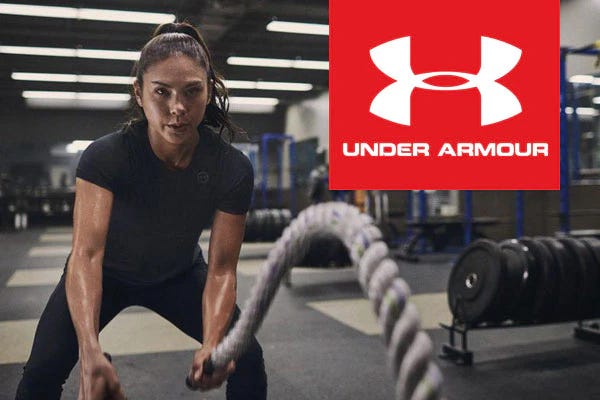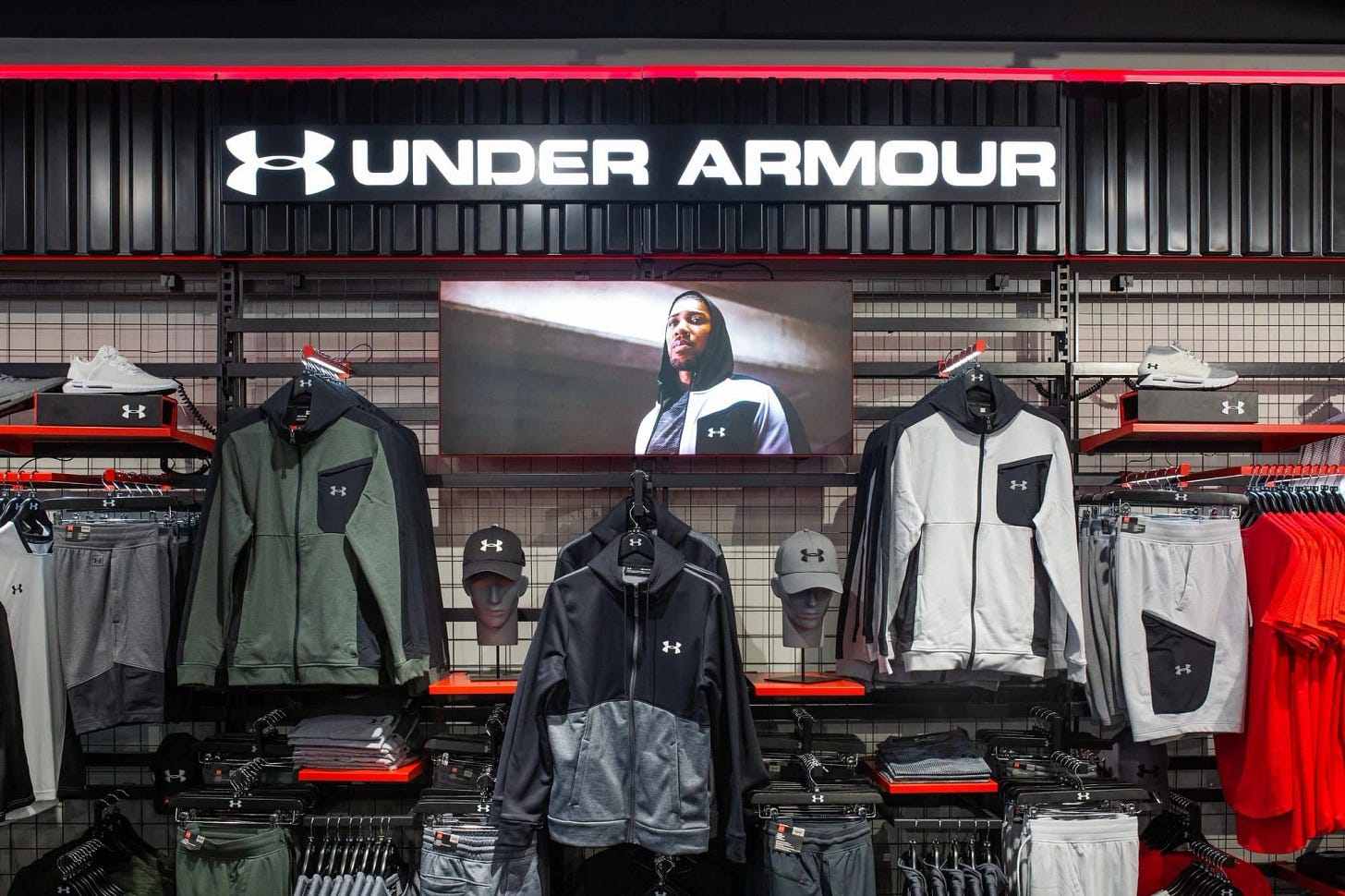Under Armour’s Game Plan: Innovation, Grit, and Global Success
Under Armour is one of the most iconic brands in the sports apparel industry, known for its innovative products and relentless pursuit of excellence. Founded in 1996 by Kevin Plank, the company quickly became a powerhouse in performance-driven athletic gear designed to enhance athletes' potential 🌟.
Curious about how this brand transformed into a household name? Check out my previous article, A Brief History of Under Armour, for some fascinating insights!
But how does Under Armour actually work and generate revenue? From strategic partnerships with top athletes to its strong direct-to-consumer model, here's a breakdown of the brand’s success strategy.
Let’s dive in! 🏃♂️
🔗 Contents
Introduction to Under Armour: A leading athletic apparel company.
Under Armour's Business Model: Focusing on high-performance products.
Revenue Streams: How Under Armour makes money.
Marketing & Branding Strategies: Leveraging athlete endorsements.
Product Innovation: Cutting-edge technology and materials.
Retail & Distribution Channels: Direct-to-consumer, wholesale, and e-commerce.
Challenges & Future Prospects: How Under Armour is navigating competition.
🏁 Introduction to Under Armour
Under Armour, founded by Kevin Plank in 1996, is a pioneer in sportswear and footwear. By focusing on innovation and performance, it quickly gained popularity among athletes and fitness enthusiasts worldwide 🌍. Their mission?
"Make all athletes better through passion, design, and relentless innovation." 💡
With a deep commitment to high-quality products, Under Armour’s loyal customer base spans from professional athletes to fitness lovers 🏋️♀️.
📌 Company Info:
Website: underarmour.com
Products: Footwear, sportswear, casual apparel
🛠️ Under Armour's Business Model
How does Under Armour maintain its competitive edge? Let’s break it down:
Product Innovation 🧬
Under Armour’s constant investment in R&D has led to some of the most advanced athletic apparel and footwear. With products like HeatGear for temperature regulation and Charged Cushioning for extra support, their gear is designed to improve athletic performance.Brand Partnerships 🏆
They’ve teamed up with top-tier athletes like Stephen Curry and Tom Brady to boost visibility and credibility. These strategic endorsements are real-time drivers of customer interest, helping Under Armour gain global recognition.Direct-to-Consumer Sales 🛒
With a focus on their e-commerce site and retail stores, Under Armour takes control of pricing and customer experience. This direct model allows them to build stronger relationships with their customer base and capture more value.International Expansion 🌍
Under Armour has expanded globally by opening stores in key markets and partnering with local retailers. This move allows them to diversify revenue streams, reducing reliance on the US market alone.Technology Integration 📲
By integrating wearable tech and fitness apps like MyFitnessPal, Under Armour adds value through connected fitness experiences. This seamless blend of tech and apparel appeals to the modern, tech-savvy athlete.
💰 Revenue Streams
Wondering how Under Armour earns its money? Here’s a quick breakdown:
Footwear Sales: Sports-specific shoes for running, basketball, and training.
Apparel Sales: High-performance clothing for athletes and casual wearers.
Licensing & Sponsorships: High-profile athletes and sports teams endorse their gear.
Direct-to-Consumer Sales: Through retail stores and e-commerce platforms.
Wholesale: Partnering with department stores and sporting goods retailers.
Connected Fitness Platform: Subscriptions and advertising revenue from apps like MapMyRun and MyFitnessPal.
🎯 Marketing & Branding Strategies
Under Armour has built a powerful brand by investing in athlete endorsements and high-energy campaigns 💥. Their marketing often highlights intense training sessions, showcasing how their gear enhances performance. By associating with top athletes, they’ve positioned themselves as the go-to brand for serious athletes.
Real-Time Insights 📊
Under Armour’s focus on data-driven marketing means they’re constantly analyzing real-time trends to refine campaigns and better connect with their audience. From social media buzz to influencer partnerships, they stay ahead of the curve in branding.
🚀 Product Innovation
Innovation is in Under Armour’s DNA. Their R&D team consistently develops cutting-edge materials and technologies that push the boundaries of performance apparel. HeatGear, for instance, is designed to wick sweat away, while ColdGear retains warmth without adding bulk.
Their collaborations with athletes like The Rock also bring real-world feedback to the design process 🧑🔬. These partnerships allow them to create products that cater specifically to athletes' needs, ensuring top performance 🔥.
🛍️ Retail & Distribution Channels
Under Armour reaches its customers through a multi-channel strategy:
Online Sales via underarmour.com
Physical Retail Stores for an in-person experience
Wholesale Partnerships with major retailers like Dick’s Sporting Goods and Nordstrom
This omnichannel approach helps them cater to various shopping preferences while increasing brand exposure.
🔮 Challenges & Future Prospects
Even as Under Armour thrives, it faces several challenges:
Fierce Competition 🆚 from giants like Nike and Adidas.
Evolving Consumer Preferences 💼, where comfort and style are increasingly prioritized.
Global Expansion 🌐 into untapped markets presents both an opportunity and a logistical challenge.
Sustainability 🌱: With consumers demanding more eco-friendly products, Under Armour has a chance to lead in sustainable innovation.
In a world increasingly driven by e-commerce, Under Armour’s ability to grow its digital sales will be a key determinant of future success.
Conclusion: Under Armour—A Brand Obsessed with Innovation and Performance 🏅
Under Armour’s journey is a masterclass in relentless innovation, smart partnerships, and staying true to their core audience. Whether it’s through groundbreaking products, athlete collaborations, or cutting-edge technology, the brand continues to evolve and adapt to ever-changing market conditions.
Key Takeaways for Product Managers:
Prioritize Innovation: Continuously invest in research and development to stay ahead of the curve. Embrace new technologies that enhance product performance.
Leverage Strategic Partnerships: Collaborate with influential figures in your industry to boost credibility and visibility.
Direct-to-Consumer Focus: Control your pricing and customer experience by building strong direct relationships with your audience.
Embrace Data-Driven Marketing: Analyze real-time trends to refine your marketing strategies and connect with your customers more effectively.
Be Adaptable: Stay responsive to changing market conditions and consumer preferences and be open to exploring new revenue streams.
So, the next time you slip on your Under Armour gear, remember—you’re wearing the result of a brand committed to making athletes (and everyday folks) better, stronger, and faster every single day. 💪
💬 Got a favorite Under Armour product? Drop it in the comments below—I'd love to hear your go-to gear! 👇
What’s Next? Stay Tuned for More Brand Growth Strategies 🚀
This is just the tip of the iceberg! In the upcoming weeks, I’ll be diving deeper into growth strategies from other top brands and uncovering how they win at customer acquisition, retention, and more.
👉 Don’t forget to subscribe and stay tuned for more brand insights that will help you build, scale, and optimize your product strategy! ✨
#UnderArmour #AthleticApparel #ProductInnovation #Sportswear #BusinessStrategy #D2C #FitnessTech #AthleteEndorsement #GlobalExpansion #Sustainability







